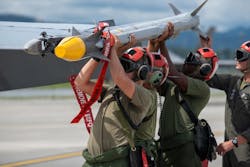Navy asks Raytheon to prepare ramping-up production of AIM-9X air-to-air infrared-guided aircraft missile
PATUXENT RIVER NAS, Md. – U.S. Navy aerial warfare experts are asking Raytheon Technologies Corp. (RTX) to prepare to increase infrared-guided air-to-air missile production to as many as 2,500 per year, under terms of a $74.8 million order announced late last month.
Officials of the Naval Air Systems Command at Patuxent River Naval Air Station, Md., are asking the RTX Raytheon segment in Tucson, Ariz., for additional non-recurring tooling, equipment, and labor to increase the annual AIM-9X production capacity to 2500 in support of the U.S. Navy, Air Force, Army, and foreign allies.
The AIM-9X is an infrared-guided heat-seeking missile that equips most jet fighters, fighter-bombers, and other offensive combat aircraft in the U.S. arsenal, and is for shooting down enemy aircraft close-by. The AIM-9X works by homing in on an enemy aircraft's hot engine exhaust. Variants of the AIM-9 Sidewinder have been deployed since the 1950s.
The AIM-9X is among the latest versions of the AIM-9 missile family. It entered service in 2003 on the Navy F/A-18C Hornet fighter-bomber and on the U.S. Air Force F-15C jet fighter. It has an imaging infrared focal plane array seeker with 90-degree off-boresight capability for accuracy.
The missile is compatible with helmet-mounted displays such as the U.S. Joint Helmet Mounted Cueing System, and features 3-D thrust-vectoring control for increased turn capability. The AIM-9X also includes an internal cooling system.
This contract involves the latest versions of the AIM-9X, called the AIM-9X Block II and AIM-9X Block II-plus. This newest version has lock-on after launch capability for use with the F-35 Lightning II joint strike fighter and the F-22 Raptor advanced tactical fighter.
The AIM-9X Block II-plus features specialized external materials to enhance aircraft survivability for the F-35. Until another version of the AIM-9X is developed that will fit inside the F-35's enclosed weapons bay, the AIM-9X Block II-plus has stealthy coatings and structures to help reduce the missile's radar cross-section when the F-35 carries these missiles externally.
On this order Raytheon will do the work in St. Albans, Vt.; Simsbury, Conn.; Keyser, W.Va.; Tucson, Ariz.; Murrieta, El Cajon, Goleta, and Anaheim, Calif.; St. Petersburg, Fla.; Midland, Ontario; Anniston, Ala.; Vancouver, Wash.; Niles, Ill.; Heilbronn, Germany; Logan, Utah; Lexington, Ky.; and other U.S. locations, and should be finished by July 2026.
For more information contact RTX Raytheon online at www.rtx.com/raytheon, or Naval Air Systems Command at www.navair.navy.mil.
About the Author
John Keller
Editor-in-Chief
John Keller is the Editor-in-Chief, Military & Aerospace Electronics Magazine--provides extensive coverage and analysis of enabling electronics and optoelectronic technologies in military, space and commercial aviation applications. John has been a member of the Military & Aerospace Electronics staff since 1989 and chief editor since 1995.
